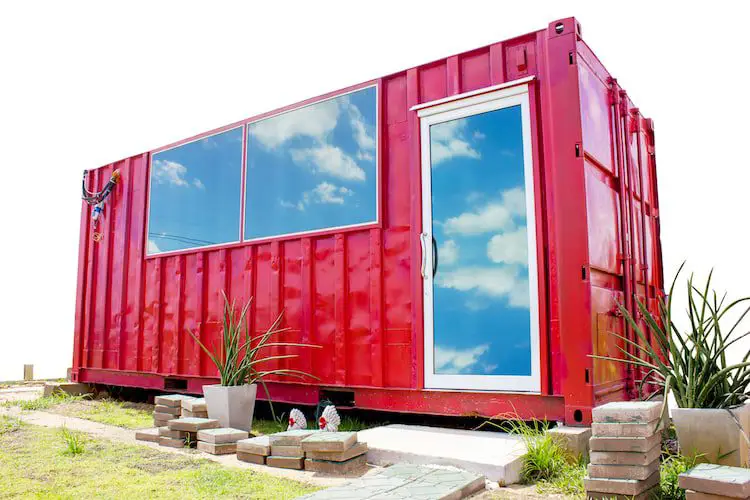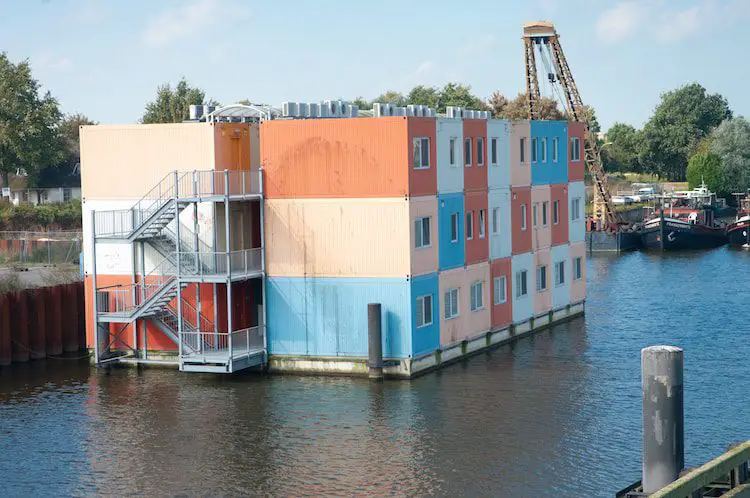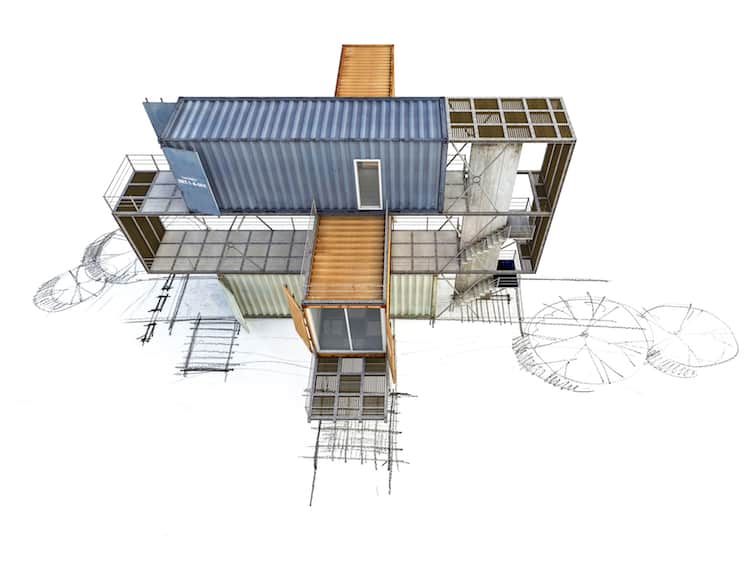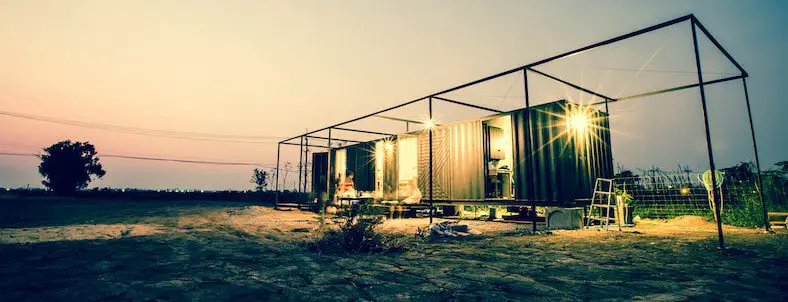The new craze for small living spaces appears to be living in container homes. And yes, by that we do mean actual shipping containers, 8 ft x 8ft 6in, with around 150 sq feet of space – converted into living spaces.
It sounds bizarre at first glance, so we decided to do some research and find out if there is actually some sense behind this idea, and found that it’s actually nothing new at all. People have been living in repurposed shipping containers for decades, especially in towns around ports in developing countries
We have looked at the safety concerns, practicality, cost and environmental impact of buying and converting containers into homes and shared our findings below. This should give you an insight into the realities of living in a container box – who knows, maybe you will be tempted to downsize.

Safety Concerns Of Container Box Living
Before we get into the finer details, it is best to begin with the fundamental requirement of a potential living space – is it safe?
Obviously shipping containers are not designed to be human homes – their primary function is to transport goods across oceans for weeks on end. To enable them to keep the goods inside dry during stormy seas and free from infestations they are treated in two ways that make them questionable for habitation.
Firstly, the floors are wooden, and are soaked in pesticides.
Secondly, the walls are coated in a strong paint containing phosphorus and chromate to protect from salt water and storms at sea.
These two aspects are obviously of real concern to individuals considering converting them into homes.
There are of course a few ways to protect yourself from exposure to the chemicals, some more costly than others.
- If purchasing a new container, you can specify to the manufacturer that you will be using it as a home – and then they won’t have to treat the walls and floor.
- For the most part second hand containers are used – and in this instance you can ask the manufacturers what your container has been treated with. They can track the container’s unique ID number.
- If you find out that yours has indeed been treated there are 2 ways to make the space safe for habitation.
- The first option is pretty expensive, but very thorough. The container can be given a full sandblasting to strip the hazardous coating from the walls, plus the floors can be replaced.
- Non breathable flooring underlay can be laid inside the container, on top of the pesticide treated floor – and then tiles used on top. Spray foam insulation can be used on the internal walls to create a vapour barrier.
Other worries about safety of living in a shipping container include concerns over the ability of such a home to withstand hurricanes. The good news is that they are strong and durable, so should be able to bear hurricanes and floods rather well. They have even been chosen as emergency disaster housing in some instances.
The containers are built to be very tough, and have a life span of somewhere in the region of 30 years.

Environmental Impact Of Container Box Living
Container boxes are often chosen as living spaces by people looking to reduce their carbon footprint on the planet.
When you realise that there are literally tons of unused storage containers taking up space this makes sense. It proves too expensive to ship empty containers back to their destination, and it works out cheaper to buy new ones in Asia (which is typically the source of most of the world’s imports).
This means that the destinations receiving goods from China and elsewhere are ending up with stockpiles of empty containers everytime a shipment arrives.
Finding a way to upcycle these into living spaces is therefore a very helpful way to combat the growing piles of empty containers that are growing at an astonishing rate.
Once converting them into a home, you can push your green scale even higher if you make it sustainable. Including solar panels and water tanks would do just this, while providing the added benefit of reducing your bills.
On the flip side of this is the argument that it could actually require more energy to convert a container into a home than building a similar structure from wood.

Cost Of Container Box Living
With house prices constantly rising it can be very difficult to get started on the home-owning ladder. It is not always desirable to spend years and years paying rent while trying to save a deposit to purchase a house.
The cost of shipping container homes can be very affordable by comparison. It is said to cost on average, somewhere in the region of $35,000 to pay for and convert a home created with 2 containers.
The cost of large shipping containers themselves would set you back around $2,000. There is a requirement for the relevant permits, planning and regulation, which also come with a bill, but the renovations themselves can be done to some degree according to your own budget.
Practicality Of Living In A Container
The first practicality to consider when deciding to live in a container home is the space. They are pretty tiny! And if they need to be insulated, it becomes even smaller – with ceilings lower than 8 feet – plus of course the shape means that you will be working with a long narrow area.
The plus side is that they are very mobile. You can have them delivered wherever you need them, and depending on the design, they can be literally portable. Providing you put them on the back of a trailer rather than a chopper, this should be a realistic thing to do.
Designers and architects have proven that they can transform the limited space almost magically into anything you need. You could use one as an office, bedroom, spa…. or entire home.
The size means that you are restricted in choices of furniture, but this doesn’t have to be a deal breaker by any means. Take a look around this example to see how it can work.
They are a practical choice of homes to be used in densely populated or lower income areas – with containers used as stackable apartments. Amsterdam is home to the ‘largest container city in the world’ which has been built for 1,000 students. The units are said to be very comfortable, with a balcony, bathroom, kitchen, sleeping room, study room and large windows in each. The rent is €450 a month, making them far cheaper than most other options in the area. One resident, Ader, had his doubts at first, but told the Guardian:
“There aren’t many disadvantages. I myself wouldn’t want to share with my girlfriend – the container is a bit too small for that, although we do have some couples living here and they’re happy. I think this kind of housing works best for single people who need something a little bit cheaper.”
Some people choose to use containers as a second, secret home in the woods, and this has led to questions around their security. Is it safe to leave them for months at a time?
Well, as containers, they are designed to be air tight and impenetrable. Obviously when parts are removed this reduces the overall security – but when doors and windows are fitted, the container home would be just as secure as a traditional home – with the added benefit of the shipping container door, which can be used to seal it all up.

A Solution For Homelessness?
Take a look at the following vision of architect Peter DeMaria. He wants to use his extensive experience and knowledge of building container homes as a solution for the 1.6 billion people currently living without adequate housing across the world.
THE CONDITION
The primary reason people experience homelessness is because they cannot find housing they can afford.
WHO – LOCALLY
578,424 homeless people in the United States
216,197 are people in families
362,163 are individuals
84,291 are “chronically homeless”
49,933 are VeteransWHO – GLOBALLY
100 million homeless people in world
1.6 billion living without adequate housingTHE SOLUTION
The statistics above, combined with our work over the past ten years, have informed our future. Our past client base has been part and parcel to research, development and successful construction of projects utilizing cargo containers. Their bold commitment to pursuing a “how do I want to live” life instead of the “how have I lived” mindset, has paved the way for a nationwide embracing of containers as a viable building block. We are indebted to our past clients and we’ll continue to serve those who commission us to bring excellent solutions to their design challenges. The container “architectural movement” continues and we’re subscribing to even greater design challenges. We have an obligation to utilize our knowledge and design prowess to improve the quality of life for as many people as possible – across the globe. Our developments and design solutions with the ubiquitous container have become the vehicle by which we pursue our vision.
We’re deeply rooted in the genesis of container housing/building solutions. It’s now time for us, and the containers, to fulfill a larger role on the planet. Over the next month, Logical will be introducing it’s most affordable line of building solutions – high design and construction quality at an affordable price point. Please stay tuned and if you like what you’re reading, join us.
Peace,
Peter DeMaria AIA,
Architect

Where To Start
If you are starting to feel curious about changing your own reality to include living in a shipping container, then be encouraged by the fact that they are pretty simple to build. They actual process is very quick too. Of course, there is some preparation involved – you would need to have a few things in place before you begin.
- Find your container and establish the chemical safety as per the beginning of this article. It is best to start looking locally with your closest ports to reduce your delivery costs.
- Procure a plot of land.
- Set a suitable foundation – this is usually a simple concrete slab, with steel enforcers that are welded to the container. There are building regulations that would need to be adhered to.
- Doors and windows need to be cut using specialist equipment that can handle the extremely thick steel.
- Depending on the climate, insulation would need to be installed on the inside and/or sun reflective paint used on the outside. There are many options here that would depend on your budget and location.
- Utilities would need to be installed – plumbing and electrics for kitchen, bathroom etc – as per a traditional home.
- You will need a weather-proof roof. Of course a shipping container has a lid – but these weren’t designed for much more than storage. You can extend the life of the container by installing a traditional roof. This will also give you a chance to include solar panels and rain capturing systems too.
- Then you can go ahead and decorate to your hearts content!
Of course, if all of this sounds like hard work, you can get someone to do it all for you.
Outsource The DIY
You can buy ready made container homes, or order to your own specification using a number of suppliers easily found online. The following is an example of what you can expect:
Welcome to New Living, the exciting alternative to conventional building methods like bricks and mortar and prefab homes using modular building techniques like shipping container homes. We strive to offer an exciting, affordable and beautiful way of building their homes. We specialise in converting shipping containers, and combining it with light steel framework to come up with creative designs that can be built anywhere.
When you take the big step of building your own home, it’s always comforting to know that you are dealing with a company that can assist you from A – Z. For this reason New Living created a few packaged options which we refer to as Standard Designs. Container homes are perfect for weekend homes, holiday homes, granny flats, work-from-home offices and communal living spaces. These designs can be bought off plan, which makes your decision process easy. ~ New Living
Summary
So there you have it, a complete guide to buying and living in a container home. Maybe we have inspired you to take a look at this new eco-friendly lifestyle for yourself!
Maybe this new way of thinking about something that we have as abundant junk in the world, could really be a game changer for the planet. For other options, you can check out passive houses.
“…Any intelligent fool can make things bigger, more complex, and more violent. It takes a touch of genius — and a lot of courage — to move in the opposite direction…” ~ Albert Einstein
If you already live in a container home then please get in touch! We would love to hear from you.
And of course, if there is any aspect that we have missed, please comment below.








Thank you for sharing a blog about the realities of buying and living in container homes. I really appreciate it and very grateful that I was able to read it.